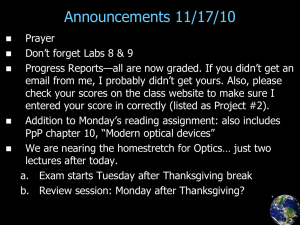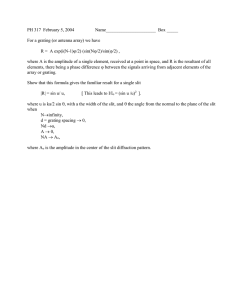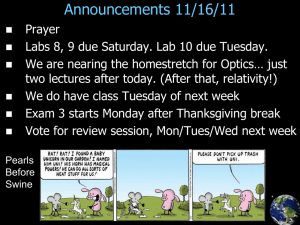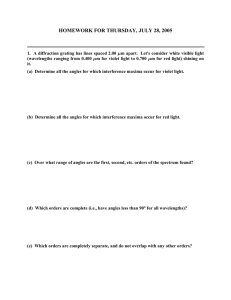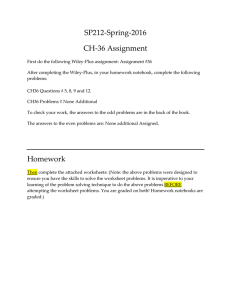Announcements 11/14/12
advertisement
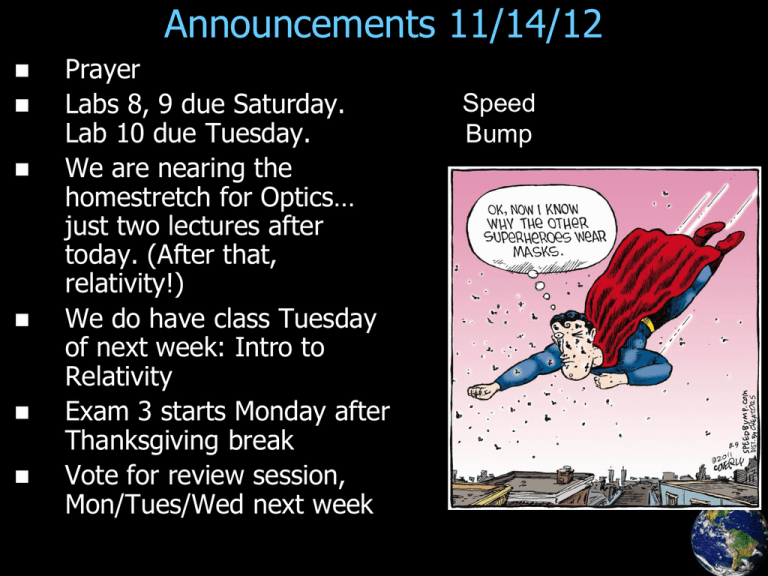
Announcements 11/14/12 Prayer Labs 8, 9 due Saturday. Lab 10 due Tuesday. We are nearing the homestretch for Optics… just two lectures after today. (After that, relativity!) We do have class Tuesday of next week: Intro to Relativity Exam 3 starts Monday after Thanksgiving break Vote for review session, Mon/Tues/Wed next week Speed Bump From warmup Extra time on? Other comments? From warmup: As shown below, the diffraction pattern of a single slit has a broad maximum in the middle, then narrower maxima to the sides. How does the intensity of the broad middle peak compare to the intensity of the closest side peaks? a. b. c. d. e. Broad peak is a lot more intense (~21x) Broad peak is a little more intense Same intensity Side peaks are a lot more intense Side peaks are a little more intense From warmup: This is the diffraction pattern for a single wide slit. What will happen to the pattern if the slit is made narrower? (The bottom physical pattern not the top mathematical plot.) a. If the slit is made narrower ("a" decreases), then the spacing between minima and maxima will increase. That is, the pattern will spread out. Review: Interference from slits Quick writing: Using no equations, and in hopefully no more than two sentences, please explain the basic idea(s) behind solving slit problems. A “wide” slit (book: “narrow” slit) HW 34-3. How do we solve this? “a” = width of slit a sin Result: I ( ) I 0 sinc yscreen approx.2: sin L 2 New function: sinc(x) sin x What is lim x0 x sin x x The sinc function [sinc(x)]2 sinc(x) 1.0 1.0 0.8 0.8 0.6 0.6 Image credit: http://scripts.mit.edu/~tsg/ www/list.php?letter=Q 0.4 0.4 0.2 0.2 15 10 5 5 0.2 10 15 15 10 5 0 5 10 15 10 0 15 10 5 0.2 0.4 0.6 0.8 5 2 1.0 a sin I ( ) I 0 sinc 15 Single slit max/min Under what conditions will you get a min? Under what conditions will you get a max? What you need to know Not given on exam Given on exam 2 PL PL d sin E E0 e I~ E i1 e i2 y L : y L ... 2 two narrow slits: 2 d I I 0 cos sin 2 2 one wide slit: 2 a sin I I 0sinc max : d sin m min : d sin m 12 min : a sin m Clicker question: I shine light through two tiny slits spaced by d. Then I shine the same light through a single slit with width d. Which diffraction pattern has the broadest middle peak? a. The two slit pattern b. The single slit pattern c. Both middle peaks are the same size. Image credit: Single slit diffraction pictures from Dr. Durfee λ=5a λ=a λ = a/2 λ = a/3 λ = a/5 λ = a/10 51 01 5 0.1 8.0 6.0 4.0 2.0 0 5 01 51 Demo Diffraction from a slit Diffraction from a hair (Babinet’s principle, HW 34-2) Clicker question: When you have two slits close to each other, each slit being “wide” (at least, not infinitely narrow), the intensity you get on the screen is: a. A double-slit pattern b. A “wide” single-slit pattern c. A double-slit pattern PLUS a single-slit pattern d. A double-slit pattern TIMES a single-slit pattern From warmup This is the diffraction pattern for two wide slits. (a) What will happen here if the distance between slits is made narrower? (b) What is the distance is held constant but the width of each slit is made narrower. a. (a) If the distance between slits is made narrower, the "fringes" (high frequency oscillation) will spread out, but the "diffraction minima" (low frequency oscillation) will stay in the same places. b. (b) If the width of each slit is made narrower, the diffraction minima will spread out but the interference fringes will stay in the same places. Combination of patterns mins HW 34-4 max max? 1.0 0.8 0.6 0.4 0.2 1.5 1.0 0.5 0.0 0.5 1.0 1.5 2-D patterns Pattern from x-direction Pattern from y-direction Example: rectangular aperture zoomed in x y Thought question: Which dimension of the rectangle was the narrowest? a. X b. Y Circular Aperture (more on this next time) Rectangle & Circle, side-by-side Array of Circles Clicker question: I shine light through a piece of foil which has two identical holes shaped like tiny llamas spaced apart by a distance d. What will the diffraction pattern look like? A : The same as two narrow slits separated by d. B : The same produced by a single slit of width d. C : The diffraction pattern of a single llama. D : The diffraction pattern of a single llama multiplied by the two-slit pattern. E : none of the above Credit: All llama slides are from Dr. Durfee Important: No llamas were harmed in the making of these images
